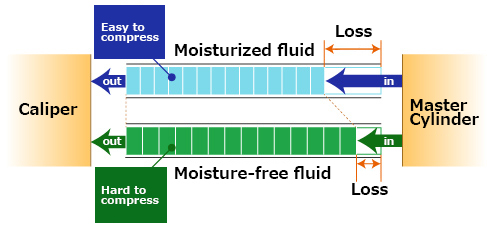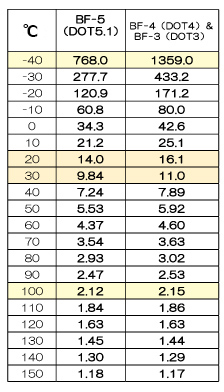| About the touch of Active Brake Fluid DOT5.1 |
About the phenomenon that the touch changes when the brake fluid is replaced. |
| |
| Voice from in-house test |
|
customer's voice |
| ・ |
The image is that the touch is clicked and the braking performance has improved dramatically. |
| ・ |
No useless force is applied to braking. |
| ・ |
The touch is stable even when the rear brake is used a lot and heat is applied. |
| ・ |
Compared to DOT4, DOT5.1 feels like the force is transmitted to the piston with a click. |
| ・ |
Good feeling of treading when braking to the back. |
|
|
| ・ |
The brakes are snappy. The clutch was clear. |
| ・ |
The touch changed from the moment I put it in. |
| ・ |
I feel that heat damage is suppressed. |
| ・ |
I compared it with DOT4, but you can see the difference immediately. |
|
|
| |
| |
We have summarized the possible factors
and data regarding the above impressions. |
|
|
| Change in compressibility due to moisture absorption |
| The touch is revived with a new fluid. |
| |
When you grasp the brake lever, the fluid is pressurized (compressed), which is converted into the force that pushes out the piston of the caliper.
Since the master and caliper are sealed, in theory the same fluid will not change the touch.
|
| |
|
However, fluid has the property of easily absorbing moisture in the air.
The more moisture is absorbed (deteriorated), the higher the compression rate becomes, and the force that grips the lever is absorbed by that amount, causing a loss of force.
Therefore, the touch tends to be clear when you replace it with a new fluid with a low water content (low loss). The same is true for fluids from any manufacturer.
|
|
High compression rate
= soft fluid |
Low compression rate
= hard fluid |
| A direct touch that works crisply |
|
 |
|
|
| |
After deterioration (moisture absorption)
The performance after deterioration (moisture absorption) can be confirmed by the numerical value of "wet boiling point".
The "wet boiling point" is the boiling point when the fluid has absorbed moisture for 2 years, and can be considered to be the same as the course in a normal usage environment. The lower the wet boiling point, the more susceptible it is to the heat damage that occurs during braking. |
| Compared to DOT4, DOT5.1 standard fluid has a higher wet boiling point and maintains high performance even after aging. However, as with DOT4, the performance will gradually decline, so regular replacement is required. |
| Wet boiling point of DOT4 / BF4: 155 ℃ or higher |
| Wet boiling point of DOT5.1 / BF5: 180 ℃ or more |
|
|
| |
Difference in touch due to stickiness
|
| Pay attention to kinematic viscosity |
| |
| |
| Dynamic viscosity at -40 ° C |
|
| DOT4:1800㎟/s or less |
| DOT5.1:900㎟/s or less |
|
 |
半分の数値。 |
|
| |
| |
| The smaller the kinematic viscosity, the higher the fluidity, and when it is replaced with the operation of the brake, the force of gripping the lever is transmitted as the force of pushing out the piston more linearly. Fluid makers describe this as " direct feeling ". |
| |
The graph below measures the change in kinematic viscosity with temperature.
DOT5.1 has a slight difference in fluidity from DOT4 even at room temperature (20 to 30 ° C).
In order for you to feel the difference in lever touch caused by this difference, Active provides an opportunity to actually try out the feel by preparing a hands-on machine when exhibiting at an event.
|
| |
| |
 |
| |
| DOT4 / DOT5.1 fluid experience machine |
| |

|
 |
| * Comparison of fluids we handle |
|
|
| |
|
| summary |
|
| ・ |
The new fluid does not contain water and has a low compression ratio, so the touch is clear. Furthermore, since DOT5.1 has low hygroscopicity, it maintains high performance after deterioration. |
| ・ |
The direct feeling of touch increases due to the difference in kinematic viscosity. |
Please try Active Brake Fluid DOT5.1!
|
|
|